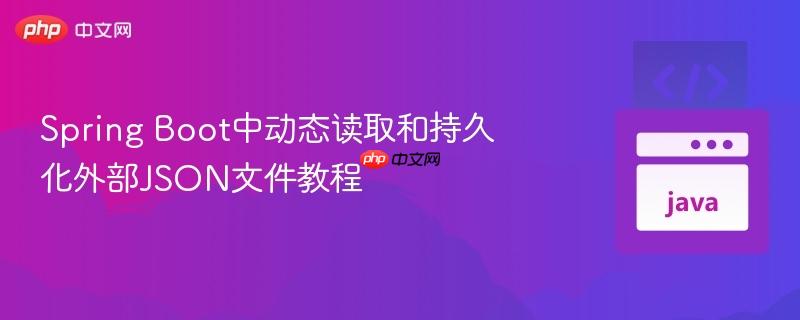
本教程旨在解决spring boot应用在定时任务中读取持续更新的外部json文件时遇到的数据无法实时同步问题。文章将深入分析`class.getresourceasstream()`的局限性,并提供一套基于文件系统路径读取的解决方案,结合最佳实践(如构造器注入)和spring `@scheduled`注解,确保应用能高效、准确地将外部动态数据持久化到数据库。
在Spring Boot应用开发中,我们经常需要处理外部数据源,例如JSON文件。当这些文件位于项目的src/main/resources目录下,并且需要被应用周期性地读取和更新数据库时,可能会遇到一个常见问题:即使外部JSON文件内容已经更新,应用通过@Scheduled任务读取到的数据仍然是旧的。
这背后的主要原因是src/main/resources目录下的文件在应用打包(如JAR或WAR)后,会被视为类路径资源。当使用Class.getResourceAsStream()方法获取这些文件的输入流时,JVM或类加载器通常会从打包好的文件中读取,并且可能对这些资源进行缓存。这意味着,即使你在文件系统外部修改了src/main/resources目录下的源文件,运行中的Spring Boot应用通过getResourceAsStream获取的仍然是打包时或首次加载时的旧版本内容,无法反映实时的外部修改。
因此,对于需要持续更新且实时读取的文件,将其作为类路径资源处理是不合适的。我们应该将其视为外部文件,通过文件系统路径直接访问。
要解决上述问题,核心在于改变文件读取策略:不再将动态更新的JSON文件视为类路径资源,而是将其作为普通的文件系统文件进行访问。
我们将对原有的Spring Boot应用进行改造,以实现动态JSON文件的实时读取和数据库持久化。
首先,在application.properties或application.yml中定义外部JSON文件的路径。

Easily find JSON paths within JSON objects using our intuitive Json Path Finder
 30
30

application.properties
json.file.path=/path/to/your/external/json/file.json # 例如:json.file.path=./data/file.json (相对于应用启动目录) # 或:json.file.path=/opt/app/data/file.json (绝对路径)
请根据实际情况替换/path/to/your/external/json/file.json。
// package com.example.demo.model;
// import lombok.Data;
// @Data
// public class Master {
// // ... 你的Master实体字段
// private Long id;
// private String name;
// // ...
// }package com.example.demo.Repository;
import com.example.demo.model.Master;
import org.springframework.data.repository.CrudRepository;
import org.springframework.stereotype.Repository;
@Repository
public interface MasterRepository extends CrudRepository<Master, Long> {
}为了遵循Spring的最佳实践,我们将@Autowired字段注入改为构造器注入。这使得依赖关系更清晰,便于测试,并确保所有必需的依赖在对象构造时就已提供。
package com.example.demo.Services;
import com.example.demo.Repository.MasterRepository;
import com.example.demo.model.Master;
import org.springframework.stereotype.Service;
import org.springframework.transaction.annotation.Transactional; // 导入事务注解
import java.util.List;
@Service
public class MasterService {
private final MasterRepository masterRepository; // 使用final修饰,强调不可变性
// 构造器注入
public MasterService(MasterRepository masterRepository) {
this.masterRepository = masterRepository;
}
public Iterable<Master> list() {
return masterRepository.findAll();
}
@Transactional // 确保保存操作在事务中执行
public Master save(Master master) {
return masterRepository.save(master);
}
@Transactional // 确保批量保存操作在事务中执行
public Iterable<Master> save(List<Master> masters) {
return masterRepository.saveAll(masters);
}
}在主应用类中,我们将注入配置的JSON文件路径,并在@Scheduled方法中通过Path和Files来读取文件。
package com.example.demo;
import com.example.demo.Services.MasterService;
import com.example.demo.model.Master;
import com.fasterxml.jackson.core.type.TypeReference;
import com.fasterxml.jackson.databind.ObjectMapper;
import lombok.Data;
import org.springframework.beans.factory.annotation.Value; // 导入Value注解
import org.springframework.boot.SpringApplication;
import org.springframework.boot.autoconfigure.SpringBootApplication;
import org.springframework.scheduling.annotation.EnableScheduling;
import org.springframework.scheduling.annotation.Scheduled;
import org.springframework.transaction.annotation.EnableTransactionManagement;
import java.io.IOException;
import java.io.InputStream;
import java.nio.file.Files; // 导入Files工具类
import java.nio.file.Path; // 导入Path类
import java.nio.file.Paths; // 导入Paths工具类
import java.util.List;
// 假设MasterList不再需要,直接读取List<Master>
// @Data
// class MasterList {
// List<Master> masterList;
// }
@SpringBootApplication
@EnableScheduling // 启用定时任务
@EnableTransactionManagement // 启用事务管理
public class ReadAndWriteJsonApplication {
private final MasterService masterService; // 使用final修饰
@Value("${json.file.path}") // 注入配置文件中的JSON文件路径
private String jsonFilePath;
// 构造器注入MasterService
public ReadAndWriteJsonApplication(MasterService masterService) {
this.masterService = masterService;
}
public static void main(String[] args) {
SpringApplication.run(ReadAndWriteJsonApplication.class, args);
// 移除TimerTaskUtil的调用,因为我们使用Spring的@Scheduled
}
@Scheduled(fixedRate = 90000) // 每90秒执行一次
public void readFileAndSaveToDatabase() {
ObjectMapper mapper = new ObjectMapper();
TypeReference<List<Master>> typeReference = new TypeReference<List<Master>>() {};
Path filePath = Paths.get(jsonFilePath); // 根据配置路径创建Path对象
try (InputStream inputStream = Files.newInputStream(filePath)) { // 使用Files.newInputStream获取实时文件流
List<Master> masters = mapper.readValue(inputStream, typeReference);
System.out.println("成功读取到数据: " + masters);
// 批量保存到数据库,Service层已添加@Transactional
masterService.save(masters);
System.out.println("数据已成功保存到数据库。");
} catch (IOException e) {
System.err.println("读取或保存JSON文件时发生错误: " + e.getMessage());
// 生产环境中应使用日志框架记录错误,如SLF4J + Logback
} catch (Exception e) {
System.err.println("处理数据时发生未知错误: " + e.getMessage());
}
}
}Path filePath = Paths.get(jsonFilePath);
if (!Files.exists(filePath) || !Files.isReadable(filePath)) {
System.err.println("JSON文件不存在或不可读: " + jsonFilePath);
return; // 提前退出
}通过将动态更新的JSON文件视为外部文件,并使用java.nio.file包提供的API进行读取,我们成功解决了Spring Boot @Scheduled任务无法实时获取更新数据的问题。同时,结合构造器注入等Spring最佳实践,使得代码更加健壮、可维护。在处理这类场景时,理解类路径资源与文件系统文件的区别至关重要,这有助于避免常见的缓存问题,并确保应用能够高效、准确地处理实时变化的外部数据。
以上就是Spring Boot中动态读取和持久化外部JSON文件教程的详细内容,更多请关注php中文网其它相关文章!

每个人都需要一台速度更快、更稳定的 PC。随着时间的推移,垃圾文件、旧注册表数据和不必要的后台进程会占用资源并降低性能。幸运的是,许多工具可以让 Windows 保持平稳运行。

Copyright 2014-2025 https://www.php.cn/ All Rights Reserved | php.cn | 湘ICP备2023035733号